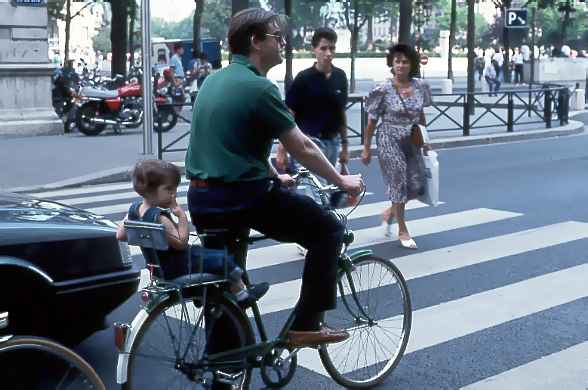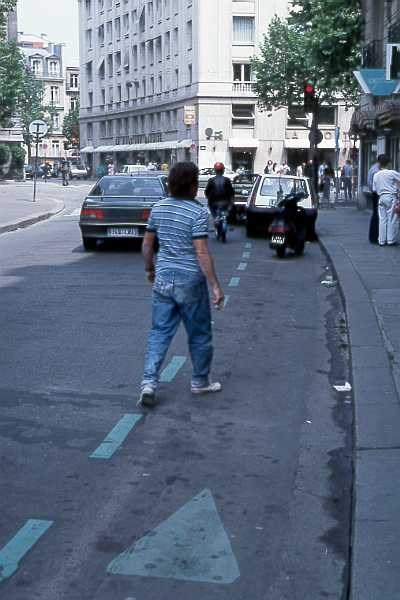
[Top: John S. Allen's Home Page]
[Up: Bicycle facilities]
[Contact John S. Allen by e-mail]
Bicycle accommodations in France -- some historical backgroundTraveling in a foreign country can often point out differences in social trends and assumptions. While on a bicycle tour in France in 1989, my wife and I discovered some differences as they relate to bicycling, and to road use in general. Until the 1980s, the prevailing assumption in France was that bicyclists would ride as drivers of vehicles, along with all the other types of traffic that use the streets. My wife and I found that French drivers were far more courteous than is typical in the USA. French drivers accepted the presence of bicyclists in the streets without question, and bicyclists rode according to the traffic law. We did not need to use explicit hand signals and assertive maneuvering to claim right of way. A common explanation for this situation is that bicycle racing is a national sport in France, and so the bicyclist on the road with you might be a sports hero. Our sense was different: bicycling was understood to be an ordinary mode of travel in France, and the bicyclist, one of your neighbors on an errand or out for a spin. After all, not all bicyclists look like sports heroes. I took the photo below near Notre Dame Cathedral in Paris. Note the equipment. The child seat is primitive, and neither the father nor the child is wearing a helmet -- to do so would have identified them as Americans. They are riding a sturdy urban utility bicycle, with fenders and generator lights. The bicycle has handbrakes and a rear derailleur, rather than the typical single-speed coaster-brake of northern Europe. But this bicyclist would not be mistaken for Laurent Fignon on his lightweight racing bicycle. |

Paris was congested with motor traffic. The air pollution was far worse than we were accustomed to in Boston or even New York. The USA had required catalytic converters on gasoline-powered motorcars since the early 1970s, and so almost the entire fleet was equipped with them by the late 1980s. The French were only just beginning to use pollution control on motor vehicles in 1989. After a day of walking or cycling in Paris, we returned to our hotel coughing and with chest congestion. We arrived at a theory that the prevalence of smoking among the French desensitized them to the nastiness of the air pollution in Paris. So, at the same time, Paris was physically unpleasant, and psychologically relaxed for us as cyclists. Smaller, provincial cities were much less congested, and so were our lungs as we rode in them. The traffic law was taught at an early age in France. As my wife and I toured in France, we noticed teenage boys in the provincial cities riding noisy, hot-rodded mopeds -- according to the traffic law. The boy in the picture below, aged about 14, is probably on his way home from school. He is waiting at an intersection in the provincial city of Loches to make a vehicular left turn. In Paris, though, most people who rode mopeds were adults. I attribute this difference to the convenience of public transportation in Paris and to a probable perception by parents that riding a moped in Paris traffic would be hazardous for a young teenager. |

|
In the USA, bicyclists are generally law-abiding except when riding bicycles. On the other hand, while US motorcyclists cultivate an image as social outcasts, they generally obey the traffic law when riding. Paris motorcyclists looked stylish, and rode new, colorful machines, but they were the only non law-abiding category of road users. They drove like madmen. I even saw one motorcyclist riding up the wrong side of a divided boulevard in Paris. Clearly, the Paris police were not enforcing the law against the motorcyclists. The crowd in the picture below nearly ran me down as I attempted to set foot in a crosswalk in Paris.The young men who ride motorcycles in Paris are similar in their motivations and habits to young men who drive fast cars in the USA, except that in Paris, a car is much more inconvenient and expensive, and there is no opportunity to drive it fast. A motorcycle is more suitable for the thrill-seeker. |

| My wife and I saw some attempts at bicycle lanes in Paris, striped with green paint. They didn't make much sense. We saw one bike lane placed in the middle of the street, in the middle of another lane. Everyone ignored it. |
Paris bike lane, 1989 (left side of photo)

Another bike lane was in the circular roadway one block outside the Place de l'Étoile. Its location, and its problems, were more conventional. We never learned much about how these bike lanes came to be installed; they had the appearance of being an attempt by an unenthusiastic city government to give environmentalist advocates of transportation reform something to quiet their complaints, but without actually doing much. |

| By 2002, as documented by my friend Paul Schimek, bicycling conditions in Paris had changed greatly, with the installation of hundreds of kilometers of special bicycle facilities. You may also view Paul's photos, with commentary. |
[Top: John S. Allen's Home Page]
[Up: Bicycle facilities]
[Contact John S. Allen by e-mail]